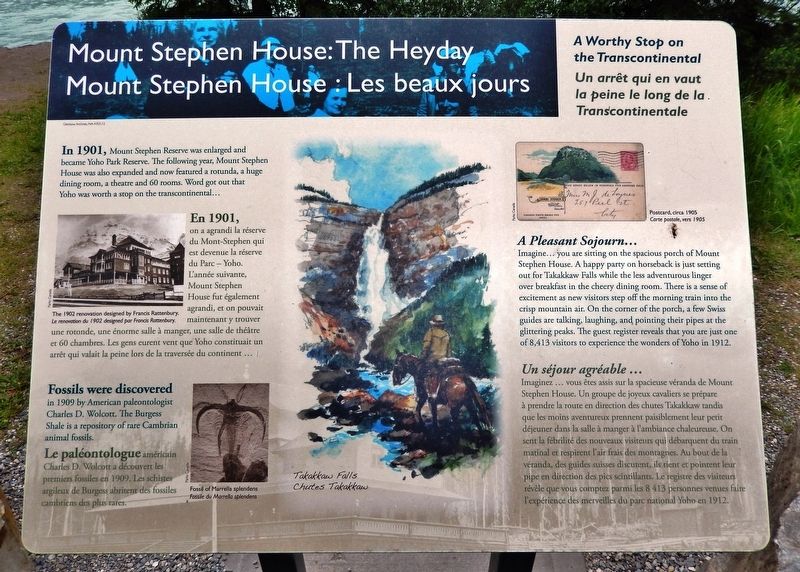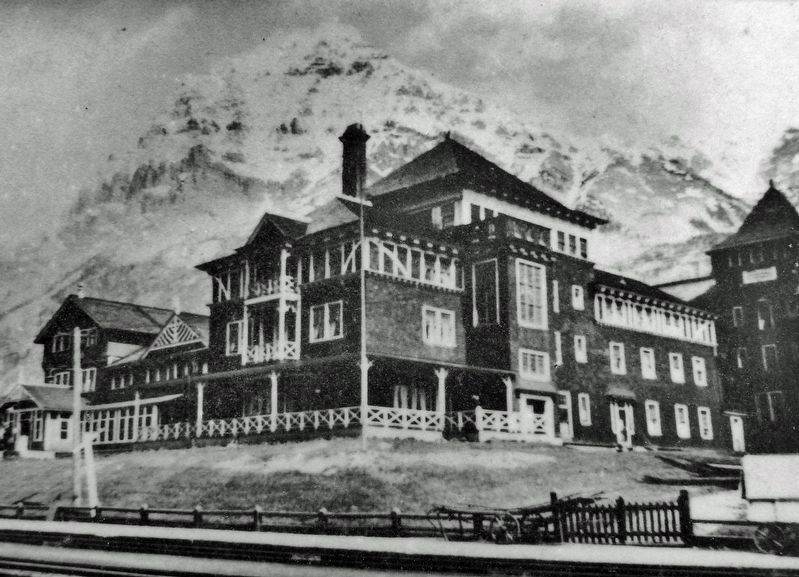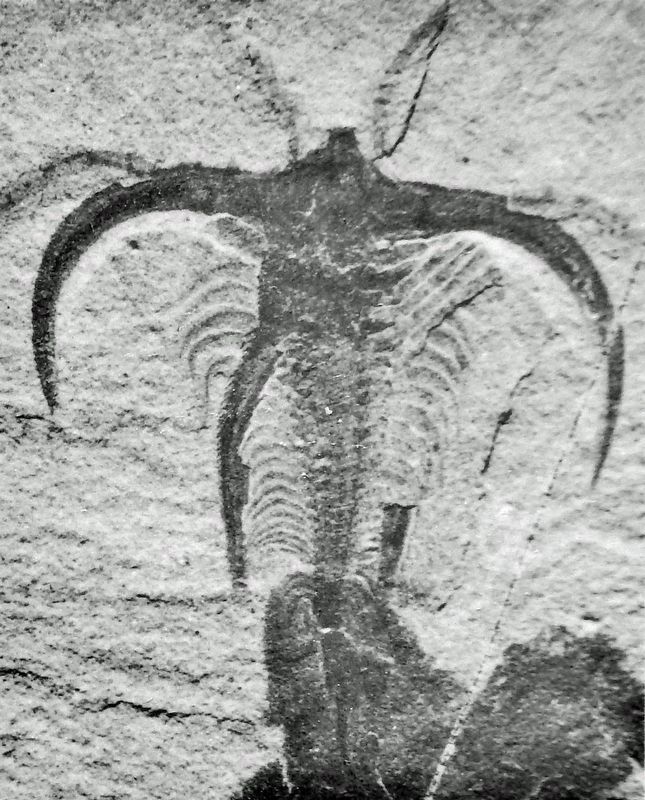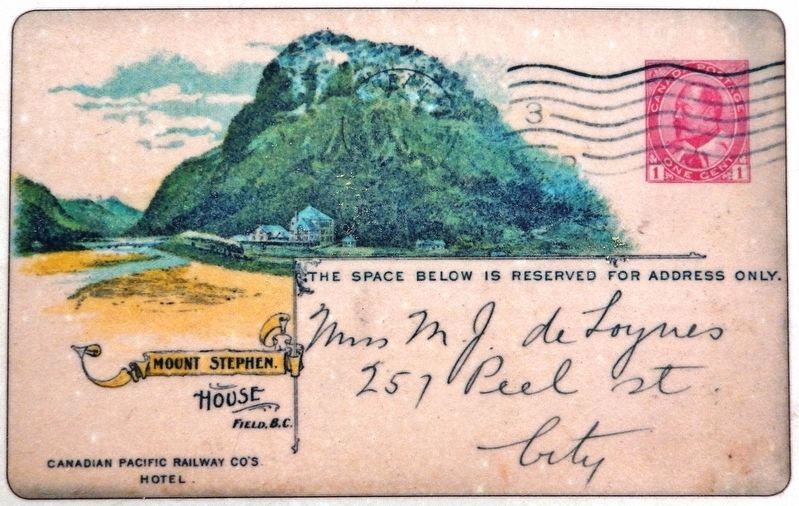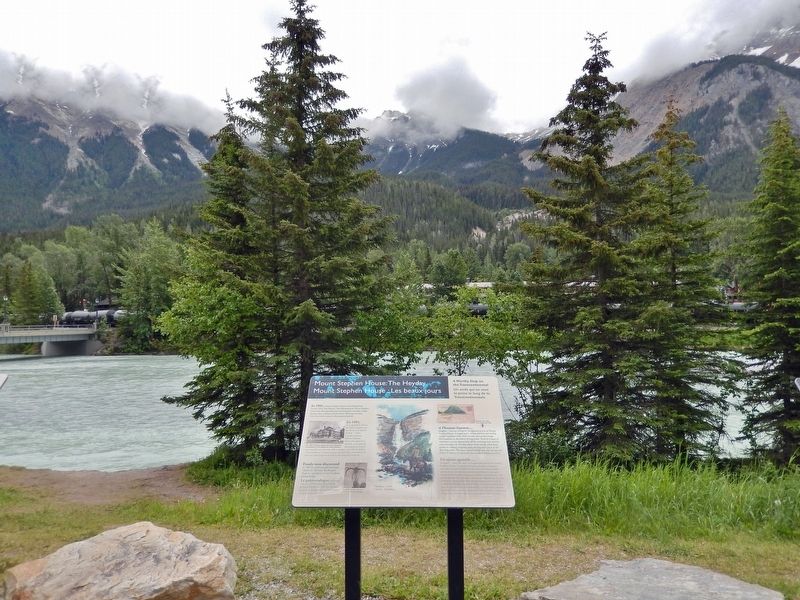Field in Columbia-Shuswap, British Columbia — Canada’s West Coast (North America)
Mount Stephen House: The Heyday/Les beaux jours
A Worthy Stop on the Transcontinental/Un arrêt qui en vaut la peine le long de la Transcontinentale
Inscription.
In 1901, Mount Stephen Reserve was enlarged and became Yoho Park Reserve. The following year, Mount Stephen House was also expanded and now featured a rotunda, a huge dining room, a theatre and 60 rooms. Word got out that Yoho was worth a stop on the transcontinental…
Fossils were discovered in 1909 by American paleontologist Charles D. Wolcott. The Burgess Shale is a repository of rare Cambrian animal fossils.
A Pleasant Sojourn…
Imagine… you are sitting on the spacious porch of Mount Stephen House. A happy party on horseback is just setting out for Takakkaw Falls while the less adventurous linger over breakfast in the cheery dining room. There is a sense of excitement as new visitors step off the morning train into the crisp mountain air. On the corner of the porch, a few Swiss guides are talking, laughing, and pointing their pipes at the glittering peaks. The guest register reveals that you are just one of 8,413 visitors to experience the wonders of Yoho in 1912.
En 1901, on a agrandi la réserve du Mont-Stephen qui est devenue la réserve du Parc — Yoho. L'année suivante, Mount Stephen House fut également agrandi, et on pouvait maintenant y trouver une rotonde, une énorme salle à manger, une salle de théâtre et 60 chambres. Les gens eurent vent que Yoho constituait un arrêt qui valait la peine lors de la traversée du continent…
Le paléontologue américain Charles D. Wolcott a découvert les premiers fossiles en 1909. Les schistes argileux de Burgess abritent des fossiles cambriens des plus rares.
Un séjour agréable…
Imaginez… vous êtes assis sur la spacieuse véranda de Mount Stephen House. Un groupe de joyeux cavaliers se prépare à prendre la route en direction des chutes Takakkaw tandis que les moins aventureux prennent paisiblement leur petit déjeuner dans la salle à manger à l'ambiance chaleureuse. On sent la fébrilité des nouveaux visiteurs qui débarquent du train matinal et respirent l'air frais des montagnes. Au bout de la véranda, des guides suisses discutent, ils rient et pointent leur pipe en direction des pics scintillants. Le registre des visiteurs révèle que vous comptez parmi les 8 413 personnes venues faire l'expérience des merveilles du parc national Yoho en 1912.
Erected by Parks Canada / Parcs Canada.
Topics. This historical marker is listed in these topic lists: Architecture
• Paleontology • Parks & Recreational Areas • Railroads & Streetcars. A significant historical year for this entry is 1901.
Location. 51° 23.851′ N, 116° 29.493′ W. Marker is in Field, British Columbia, in Columbia-Shuswap. Marker can be reached from the intersection of Trans-Canada Highway (Provincial Highway 1) and Field Access Road. Marker is located on the east side of the Yoho National Park Visitor Centre parking lot, overlooking the Kicking Horse River, and Mount Stephan in the distance. Touch for map. Marker is at or near this postal address: 5764 Trans-Canada Hwy, Field BC V0A 1G0, Canada. Touch for directions.
Other nearby markers. At least 3 other markers are within 6 kilometers of this marker, measured as the crow flies. Mount Stephen House: The Later Years/Les dernières années (here, next to this marker); Mount Stephen House: The Early Years/Les premières années (here, next to this marker); Baldwin #7717 Steam Locomotive (approx. 5.2 kilometers away).
Related markers. Click here for a list of markers that are related to this marker. Mount Stephen House
Also see . . .
1. Mount Stephen Trilobite Beds. Wikipedia entry:
The richness of fossils in the Field area was first identified by workers associated with the construction of the Trans-Canada railway, which had (somewhat controversially) been routed through the Kicking Horse valley. Richard McConnell, of the Geological Survey of Canada, was pointed to the beds by a railway worker whilst mapping the geology around the railway line in September 1886. Several unusual fossils were subsequently described from this site, including sponges, worms, and the appendages of the unusual Anomalocaris, identified at that time as the bodies of crabs. These fossils prompted Charles Doolittle Walcott to make forays into the area, and led to his discovery of the Walcott Quarry on Fossil Ridge.(Submitted on August 12, 2022, by Cosmos Mariner of Cape Canaveral, Florida.)
2. The Strange Creatures Hidden Up Mount Stephen. Trail to Peak website entry:
In 1886, railway workers, fulfilling our first Prime Minister, John A. Macdonald’s dream of connecting our vast country with a railway line, built the town of Field. The geological survey of Canada geologists came to the area to find resources to be mined. The railway workers and geologists found zinc and nickel… and stone bugs in the talus shards carried down the hillside! Fast forward to 1909. Charles Doolittle explored the mountains on horseback with his wife and two sons, searching for fossils for the Smithsonian collection. Palaeontologist and scientific administrator (head of the Smithsonian Institution), he found the famous Walcott Quarry site in 1909, 3000 feet above the town of Field and across the valley from the “stone bugs.” He returned year after year, until 1917, collecting fossils and documenting the fossil record. Each year the freeze-thaw cycle and the powerful avalanches that rock this slope release more fossils onto the mountain side.(Submitted on August 12, 2022, by Cosmos Mariner of Cape Canaveral, Florida.)
Credits. This page was last revised on August 12, 2022. It was originally submitted on August 11, 2022, by Cosmos Mariner of Cape Canaveral, Florida. This page has been viewed 113 times since then and 56 times this year. Photos: 1, 2, 3, 4, 5. submitted on August 12, 2022, by Cosmos Mariner of Cape Canaveral, Florida.
